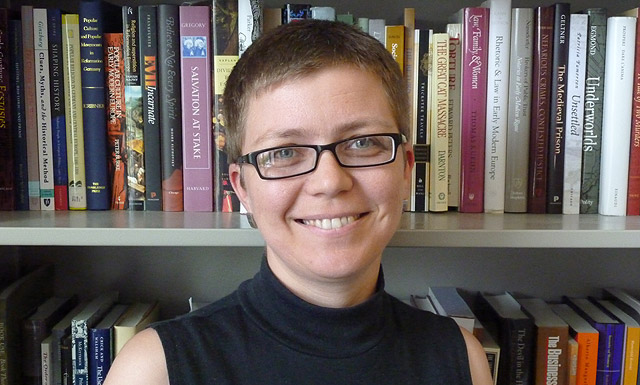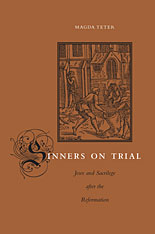5 Questions With . . . Magda Teter on Jews and Sacrilege after the Reformation

This issue, we ask “5 Questions” of Magda Teter, the Jeremy Zwelling Associate Professor of Jewish Studies, associate professor of history, associate professor of feminist, gender and sexuality studies, associate professor of medieval studies. Teter is the author of Sinners on Trial: Jews and Sacrilege after the Reformation, published by Harvard University Press in March 2011.
Q: Professor Teter, you are a scholar of religious and cultural history. What are your research interests, and what courses do you teach at Wesleyan?
A: In my writing I focus on Jewish-Christian relations, particularly in Poland, which was once the one of the largest states in Europe and also home to the largest Jewish community in the world. At Wesleyan I teach a wide range of courses mostly in Jewish history, but I also teach Early Modern European history, covering the period from mid-15th century to the French Revolution, and historiography. Having been trained at Columbia University, my courses always present Jews as actors in larger historical developments. Students taking my classes in Jewish history learn a great deal about general history. Similarly, since Jews were a crucial group in Europe greatly influencing European society, culture, economy, and politics, students taking my European history classes will learn that one cannot fully understand, for example, humanism and the Reformation without taking into account the role Jews played in them. I see both Jewish and non-Jewish history as tightly intertwined with each other. This semester I teach a course on east European Jewish history, with a service-learning component focusing on east European Judaica from the Adath Israel Museum in Middletown.
A: Like all my scholarship and teaching, my new book belongs to both Jewish and general European history. In my book I argue that religious dogmas and identities in post-Reformation Poland were not only shaped by religious education and propaganda but also by criminal courts. The mishandling of sacred symbols and objects, once seen as a sin, was transformed into crimes and led to harsh sentences, including burning at the stake, sending a strong message about validity of religious doctrines. In post-Reformation era at the center was the Eucharist — the consecrated communion wafer. My book casts a new light onto one of the most notorious accusations against Jews: that Jews obtained and abused consecrated communion wafers. It places this anti-Jewish accusation within the broader context of religious conflict after the Reformation, changing conditions of ecclesiastic authority, and competition in the economic marketplace. This broader story of politics of crime and religious violence is told through gripping individual stories of crime, intrigue, and torture. The characters in my book include a scheming papal emissary prosecuting heretics, a Jewish inn-keeper accused of blasphemy, members of Jewish-Christian gangs, and more. I tried to write an engaging book, giving voice to real people from the past, and I hope that these stories will make the book fun to read and appealing to general readers. I often joke that some of the stories could become a movie.
Q: How does this book help Jews and Catholics better communicate and understand each other today?
A: In teaching and writing about religious history, and in particular about the relations between Jews and Christians, I hope to help us all understand that many attitudes and religious views are products of specific historical conditions, and as such perhaps understanding the roots of religious differences can help us move beyond the ugliest aspects of ethnic and religious attitudes. But my work also shows that many assumptions about religious or ethnic conflicts, and in particular Jewish-Christian relations, are simply products of earlier historical writings, informed by modern nationalism and crisis of identities and searching for simpler, cleaner narratives. National and religious groups often create neat narratives of origins, yet, historical sources show a much more complex, and therefore much more interesting, history. Who would think of Jewish-Christian gangs operating in the 17th century, or Christians owning seats in synagogues?
Q: What led you to write this book, and what were some of the challenges with the research?
A: As it often happens one book leads to the next. Questions of Jews and crime emerged when I was working on my first book (Jews and Heretics in Catholic Poland, Cambridge University Press, 2006, pbk 2009; ). When I started research for this new book, my book was shaping up as a pretty straight forward book about crime, but one of the challenges was the nagging question, “So what?” The stories were compelling but why did they matter? And I finally realized that there is a big story about power, the politics of crime, manipulation of sacred symbols, and about emerging religious identities. The controversy over Muhammad’s cartoons in Denmark began to elucidate some of the issues for me.
My “epiphany” came while I was sitting in a small provincial archive in Poland reading a long account of a trial from 1630. I realized that the questions of “sacrilege” or how crimes against “the sacred” were classified by secular courts, how sin became a crime were central to the understanding religious transformations and the politics of religion in the aftermath of the Reformation. My sources were predominantly court records, but they also included pamphlets, rabbinic writings, secret correspondence between the papal nuncios and Rome. I visited over 15 archives in Poland, Rome and the Vatican City. My sources are in six languages: Polish, Latin, Hebrew, Yiddish, Italian and Ruthenian.
I am currently beginning my next book project on blood libels against Jews and the boundaries of papal power in Europe, mostly focusing on Poland—the periphery of papal influence, and Italy, its center. Last January, I began my research in the Secret Vatican Archives and the archives of what was known as the Holy Office of the Inquisition in the Vatican City. We’ll see where the sources will take me this time.
Q: As the Jeremy Zwelling Associate Professor of Jewish Studies, you also are director of the Jewish and Israel Studies Program. What does the program offer to students and the Wesleyan community?
A: The Jewish and Israel Studies Certificate Program is one of the most active cultural contributors to Wesleyan and the Middletown community. We have regular series of events: the Contemporary Israeli Voices in the Fall and the Ring Family Israeli Film Festival in the Spring. Both are run by Professor Dalit Katz, who brings to Wesleyan outstanding writers, filmmakers, poets from Israel. This gives our students an opportunity not only to read their works and watch their films but also to interact with them in classes and workshops. Etgar Keret, one of the most renowned writers in Israel, for example, is our “regular.”
The Gittel and Mervin Silverberg Distinguished Scholar in Jewish Studies allows us to bring distinguished visiting artists and scholars to Wesleyan. This semester director Haim Tabakman is teaching a course on the revival of the Israeli Cinema.
We also bring to Wesleyan several academic speakers each year, highlighting new cutting edge scholarship in Jewish Studies. One such regular event is our annual Dorothy and Samuel Frankel Lecture series. These lectures are usually linked to our curricular offerings. Last semester we offered seven events, this semester it will be fourteen, among them the six Israeli films in the Ring Family Israeli Film Festival. This semester we have a nice cluster of courses in east European Jewish culture, and Professor Mark Slobin coordinated a four-lecture series on Yiddish Cultural Expressions.
We are very active. Not only do we want to bring exciting speakers to campus but we also want to highlight our students’ research in Jewish and Israel Studies. Last year, we created our new annual series showcasing student research in Jewish and Israel Studies. This is usually our last event of the year, this year on May 3 at 4:30 in Allbritton. But before that we still have six events coming. To learn more, students can come to our open house on March 31 in Allbritton 311.
Aside from extracurricular events, JIS is also contributing to the larger Middletown community through its service-learning partnership with the Congregation Adath Israel. This semester I am teaching a service learning course working with their museum and we will curate a small exhibition of Jewish ritual objects. We also have reached an agreement with Adath Israel to deposit their rare books to the Special Collections and Archives at Wesleyan. Next semester my students and I will be working on them, curating an exhibition of Judaica books at Wesleyan. Next year’s Gittel and Mervin Silverberg Distinguished Scholar will be Professor Shalom Sabar of the Hebrew University who will teach a course on Jewish art and material culture based on the Adath Israel collection.
We are an active and exciting Program, with new ideas and collaborations sprouting out each day. We have been collaborating with the Film Studies Program, and are beginning to work with the Writing Program and the new Middle Eastern Studies Program. To keep track with everything we do—events, faculty and student accomplishments—I started a blog http://jis.blogs.wesleyan.edu/ and a Facebook page http://www.facebook.com/WesleyanJIS.


